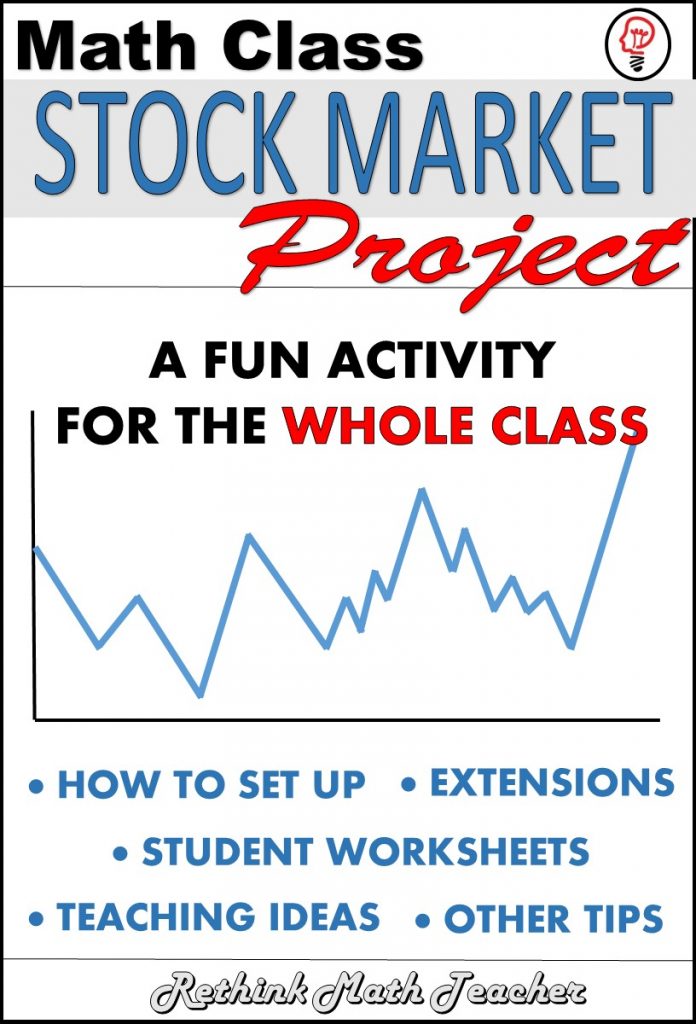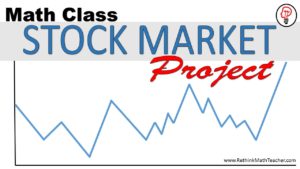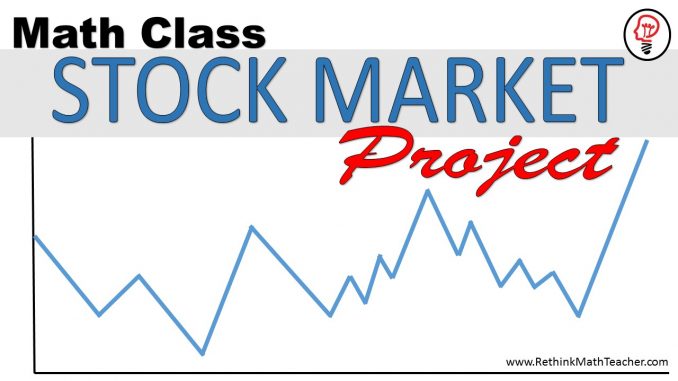
One of my favorite activities to do is a Stock Market Project. What follows will give you some helpful advice for setting up this class project, getting it started, and extending it.
During this activity, students will learn about stocks, investing, and real world application of mathematics. Plus there are tons of math concepts and skills that can be implemented.
Here’s what I do to have an engaging, and successful stock market project.
Shark Tank
To help students begin to understand the concept of owning part of a business, I show them portions of Shark Tank – the show on ABC where billionaire investors compete for part ownership of an entrepreneur’s company.`
The students enjoy watching the episodes, especially when the product is very interesting or if there is drama in the negotiations.
Watching the show also gives us a great opportunity to talk about proportions and percents – one shark wants 10% of the company for $100,000, so what is the evaluation of the company’s worth?
YouTube used to have episodes of Shark Tank available, so I had made worksheets for individual episodes. But they have all been scrubbed. So I recommend getting the episodes for free at ABC’s website, and using a generic questions worksheet like the one I use in the image below.

This worksheet is available at the bottom of this post as an editable word document.
I also recommend previewing the episode or section of the episode that you wish to show. Besides that doing so will allow you to show it in class without the commercials, there are also some products that deal with alcoholic beverages, swimsuits, or other topics that you may not want to show to your students.
I Own Disney
After talking about ownership of a stock, we then discuss that most companies are publically owned, meaning that they sell stock in their company to the public, so you and I can purchase it at a public stock exchange (like the New York Stock Exchange).
After a short discussion on companies that are publically owned, I then explain to the class that I actually own one stock in Disney. We start discussing all the ways that Disney makes money; the Marvel movies, Disney World and Disney Land, ESPN and ABC, all the Disney Princess merchandise, the Disney channel, etc.
Invariably, the students realize that Disney makes a lot of money, and assume that I must be a millionaire (since I own the company).
I then explain that there are millions of shares of Disney, and I own one of them. Each of those millions of shares must split the revenue, and the students soon come to their second epiphany: that I am not a millionaire.
We then go on to ETrade and see how much a Disney stock is worth and how much it has made this year. I guide the conversation towards the thought that if 1 stock of Disney makes a few dollars each year, how much would 1,000 Disney stocks make in a year? Which begins a conversation on wise investing and passive income.
Here’s a funny clip to show your class on the stock market’s fluctuation, from the Daily Show with Jon Stewart.
I Choose the Stocks
Prior to these discussions, I will preselect 15 – 20 different stocks that I am going to allow my students to purchase. I try to choose companies that they will know of, and be interested in.
So I choose stocks like: Snapchat, Twitter, Disney, Apple, Amazon, Walmart, Target, McDonalds, Starbucks, Dunkin Doughnuts, etc.
You can scroll down for a full list of the stocks and their stock symbols that I usually use with my classes.
The Watch List
I create a Watch List online of these 15-20 stocks so that I can quickly pull them up and show the students all the relevant information each day.
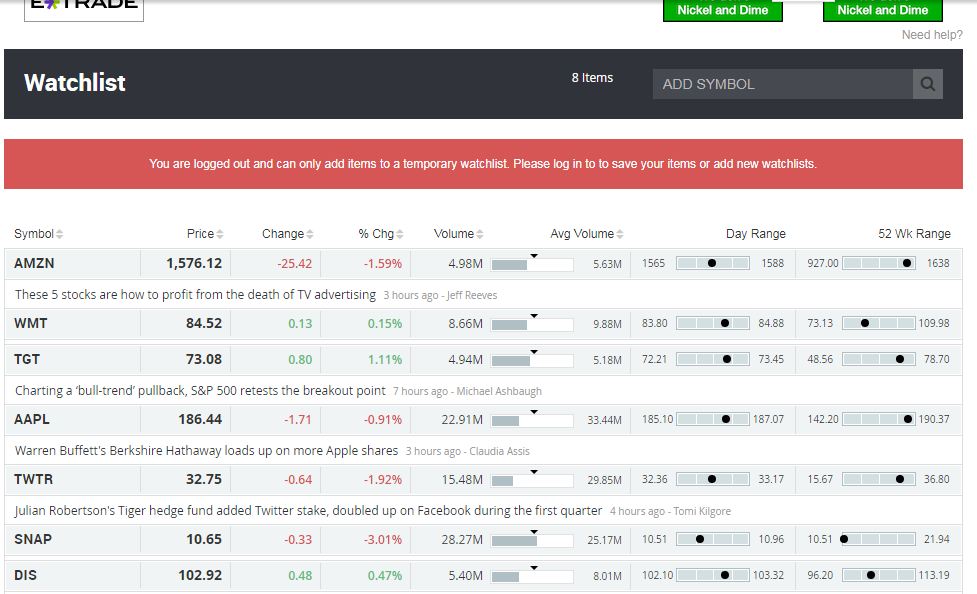
ETrade has a very cool website that allows you to build a watchlist. So I signup for an account at https://www.marketwatch.com/watchlist and enter the 20ish stocks into the watch list. Edward Jones has a similar feature at https://www.edwardjones.com/your-watch-list/index.html
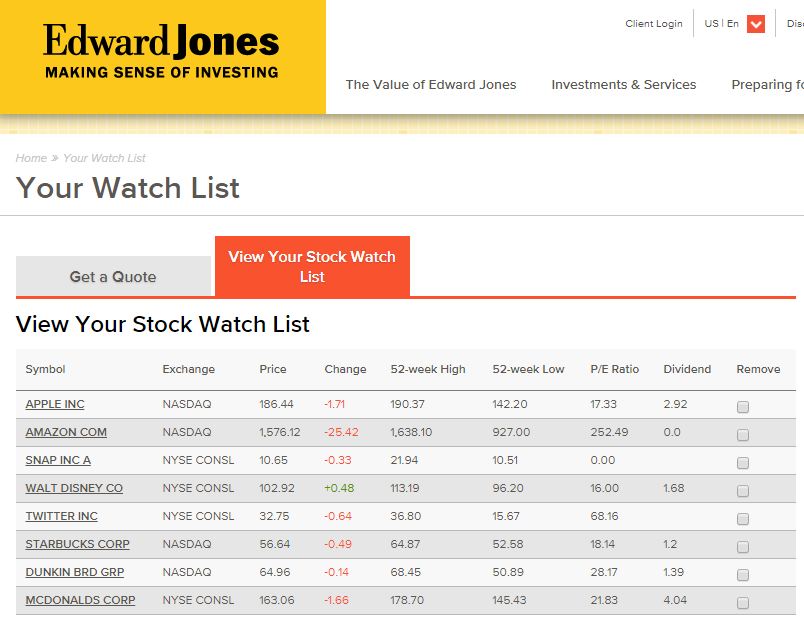
I will also create a one page handout that has a list of the stocks for the students that has 4 columns and includes the following information:
- Stock Name
- Current trading price
- 52 week high
- 52 week low
Which I will handout to the students when it’s time for them to decide what stocks they are going to invest in, and how to spend their money.
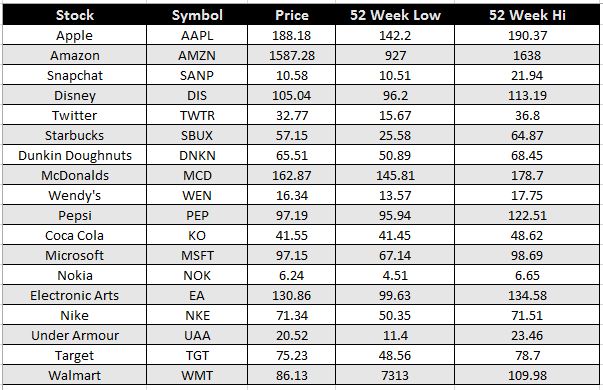
This worksheet, as seen above, is included in the download at the end of this post, as an editable form if you are interested in having it.
Purchasing Stocks
After giving some time to look at the list of stocks and ask questions, we then practice purchasing stocks.
I let the students know the rules:
- They must purchase 3 different stocks (no more, no less)
- They are given $100,000 to invest, and they must spend at least $99,000
Next, we practice purchasing stock.
I project the “Day 1 Stock Purchasing Table” on the board, and we fill it out together:
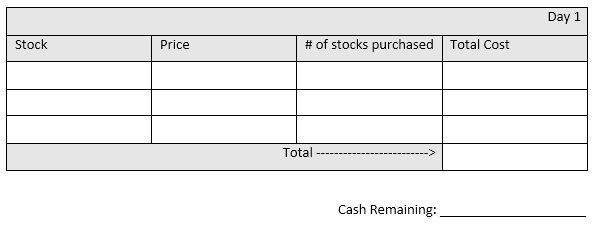
This worksheet is also included in the download at the end of this post.
Students’ Turn
Finally, the students are then tasked with investing their money and completing the same table on their worksheet.
Reminder, they must purchase 3 different stocks and they must invest at least $99,000 of their $100,000. The remaining cash that they don’t spend, they must keep track of.
You may want to give the students a day between introducing the project and beginning it – where they actually purchase the stocks – so that they can do some research.
Continuing the Activity
After the introduction, where we learn about stocks, stock prices, the stock exchange, and then actually purchase stock, the students must update their portfolios daily. This is why building the stock market watch list helps. You simply project the watch list on the board, and students can see the new price of their stock, and then do the calculations to determine whether or not they made money.
So we complete the table below to help students keep track of how much money they now have.
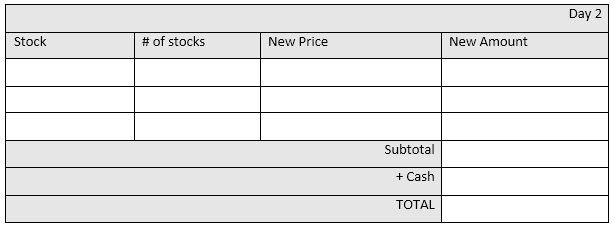
Again, I recommend first modeling this, as it is a lot of new information and they will struggle with the many steps.
It is very important to make sure that they do this correctly on day 2, as this will dictate how well they do on the remaining days, so spend some extra time checking everyone’s work and making sure that they know how to complete the table and do the calculations to find out how much money they now have.
Two Options
There are two ways to do the activity.
The first option is to NOT allow the students to alter their stock selections after the first day. So however many stocks they purchased on day 1 of each stock, remains their total for the entirety of the project. The rest of the time is spent calculating how much those stocks have grown.
The second option is to allow the students to change their selections daily. So they can purchase more of a stock, or sell some of a stock, or both. Or, students can even completely sell out of one stock and purchase a new stock all together. Students may even wish to invest some of the cash that they had remaining.
Option 2 is obviously much more involved, and more difficult to complete, but it also is more like the real world.
When choosing option 2, I have my students complete a second table each day.
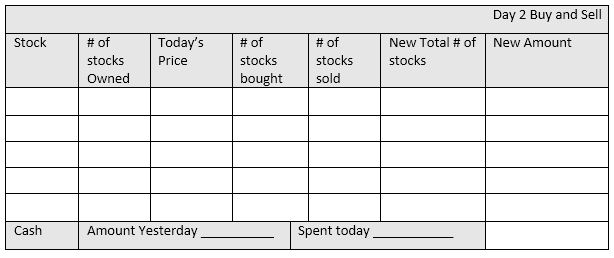
Again, all these worksheets are available at the bottom of this post.
Extension Activity
A great extension activity is to have students create line graphs.
They can do one of an individual’s stock day by day, or one of their portfolio’s value day by day.
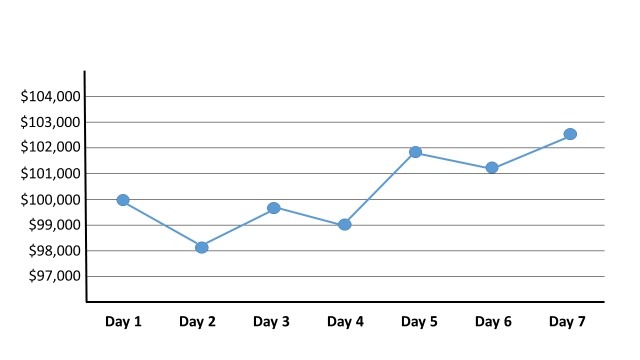
Get the Student Worksheets
Of course, I have shown you all that is on the worksheets that I use when my class does the stock market project, so feel free to reproduce them.
However, if you would like to save yourself the time of remaking them, and support this website, you can purchase all 4 worksheets.
Click Here to Purchase all 4 Stock Market Worksheets
